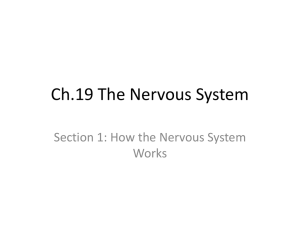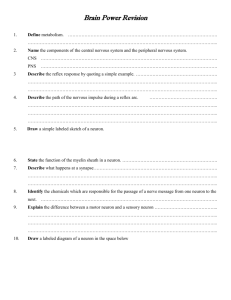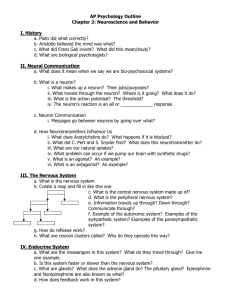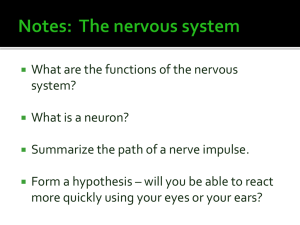Nervous and Endocrine Systems Review
advertisement
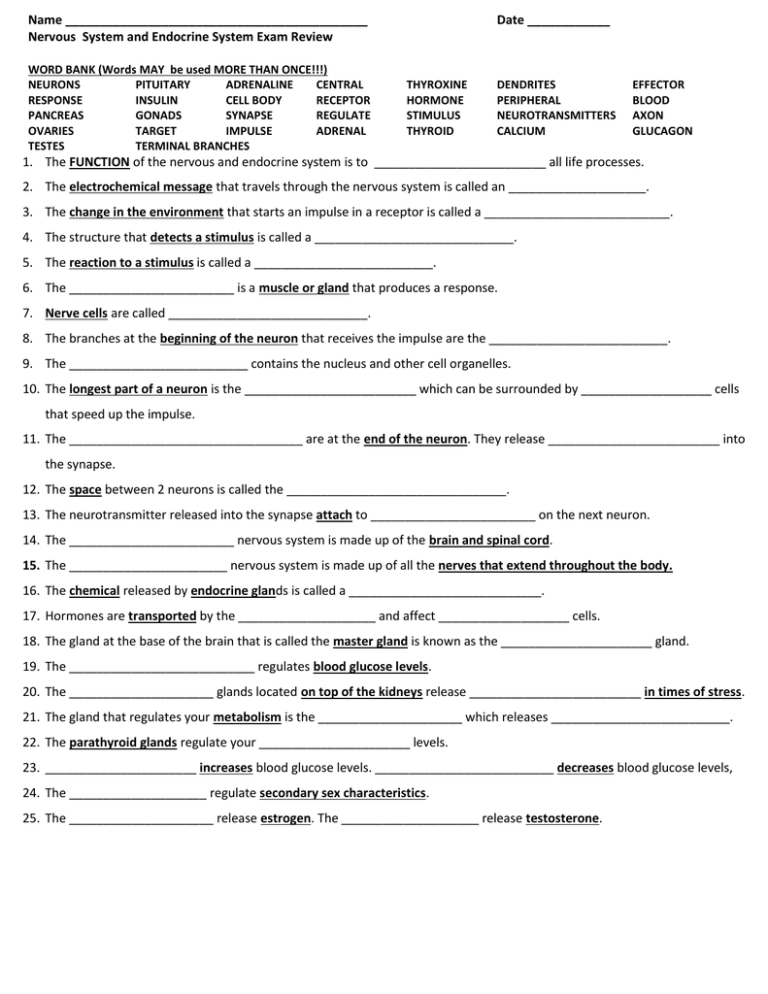
Name ____________________________________________ Nervous System and Endocrine System Exam Review WORD BANK (Words MAY be used MORE THAN ONCE!!!) NEURONS PITUITARY ADRENALINE CENTRAL RESPONSE INSULIN CELL BODY RECEPTOR PANCREAS GONADS SYNAPSE REGULATE OVARIES TARGET IMPULSE ADRENAL TESTES TERMINAL BRANCHES Date ____________ THYROXINE HORMONE STIMULUS THYROID DENDRITES PERIPHERAL NEUROTRANSMITTERS CALCIUM EFFECTOR BLOOD AXON GLUCAGON 1. The FUNCTION of the nervous and endocrine system is to _________________________ all life processes. 2. The electrochemical message that travels through the nervous system is called an ____________________. 3. The change in the environment that starts an impulse in a receptor is called a ___________________________. 4. The structure that detects a stimulus is called a _____________________________. 5. The reaction to a stimulus is called a __________________________. 6. The ________________________ is a muscle or gland that produces a response. 7. Nerve cells are called _____________________________. 8. The branches at the beginning of the neuron that receives the impulse are the __________________________. 9. The __________________________ contains the nucleus and other cell organelles. 10. The longest part of a neuron is the _________________________ which can be surrounded by ___________________ cells that speed up the impulse. 11. The __________________________________ are at the end of the neuron. They release _________________________ into the synapse. 12. The space between 2 neurons is called the ________________________________. 13. The neurotransmitter released into the synapse attach to ________________________ on the next neuron. 14. The ________________________ nervous system is made up of the brain and spinal cord. 15. The _______________________ nervous system is made up of all the nerves that extend throughout the body. 16. The chemical released by endocrine glands is called a ____________________________. 17. Hormones are transported by the ____________________ and affect ___________________ cells. 18. The gland at the base of the brain that is called the master gland is known as the ______________________ gland. 19. The ___________________________ regulates blood glucose levels. 20. The _____________________ glands located on top of the kidneys release _________________________ in times of stress. 21. The gland that regulates your metabolism is the _____________________ which releases __________________________. 22. The parathyroid glands regulate your ______________________ levels. 23. ______________________ increases blood glucose levels. __________________________ decreases blood glucose levels, 24. The ____________________ regulate secondary sex characteristics. 25. The _____________________ release estrogen. The ____________________ release testosterone. Use the diagram below to answer questions 25 - 34. Word Bank: A C DENDRITES CELL BODY AXON SCWANN CELLS TERMINAL BRANCHES NUCLEUS 26. Label structures A - F in the diagram. Write the number of the structure(s) described for #’s 27 – 33. ______27. Beginning of the neuron. B ______28. Transports impulse to terminal branches. ______29. Helps impulse travel faster. D ______30. Release neurotransmitters into the synapse. ______31. Largest part of the neuron. ______32. Contains DNA. F E ______33. Where the impulse is electrical. 34. Where is the impulse chemical? _______________________ 35. Identify the structures neurotransmitters attach to on the next neuron. _____________________________ Use the diagram below to answer questions 36 – 45. Word Bank PANCREAS ADRENAL GLANDS THYROID TESTES PARATHYROID OVARIES PITUITARY 36. Labels all structures in the diagram. Identify the gland described. 37. Releases growth hormone. ________________________ 38. Regulates calcium levels in the blood. ________________ 39. Release estrogen. ______________________ 40. Regulate glucose levels. ______________________ 41. Release adrenaline in times of stress. _____________ 42. Formerly known as the master gland. _______________ 43. Release testosterone. _______________________ 44. Releases insulin. _______________________ 45. Regulates metabolism. ______________________

